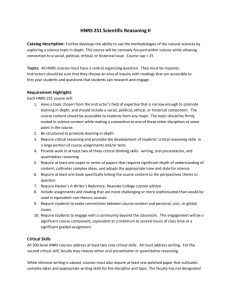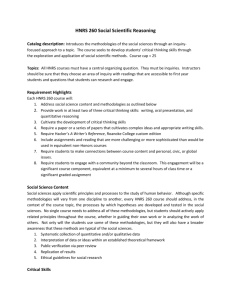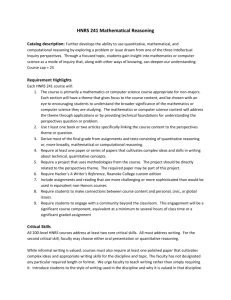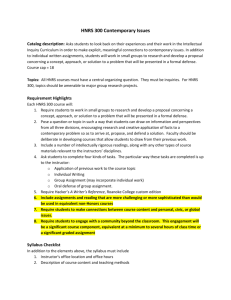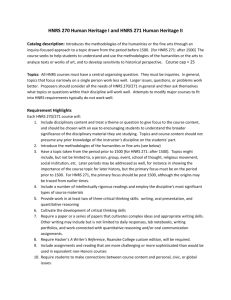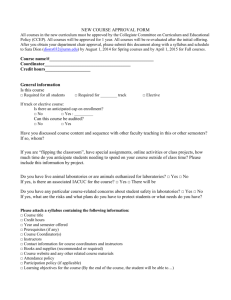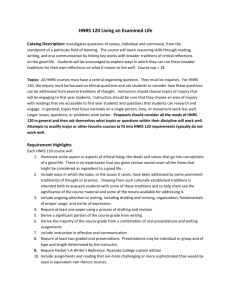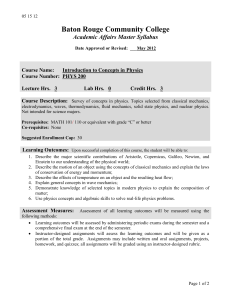HNRS 240 Guidelines
advertisement
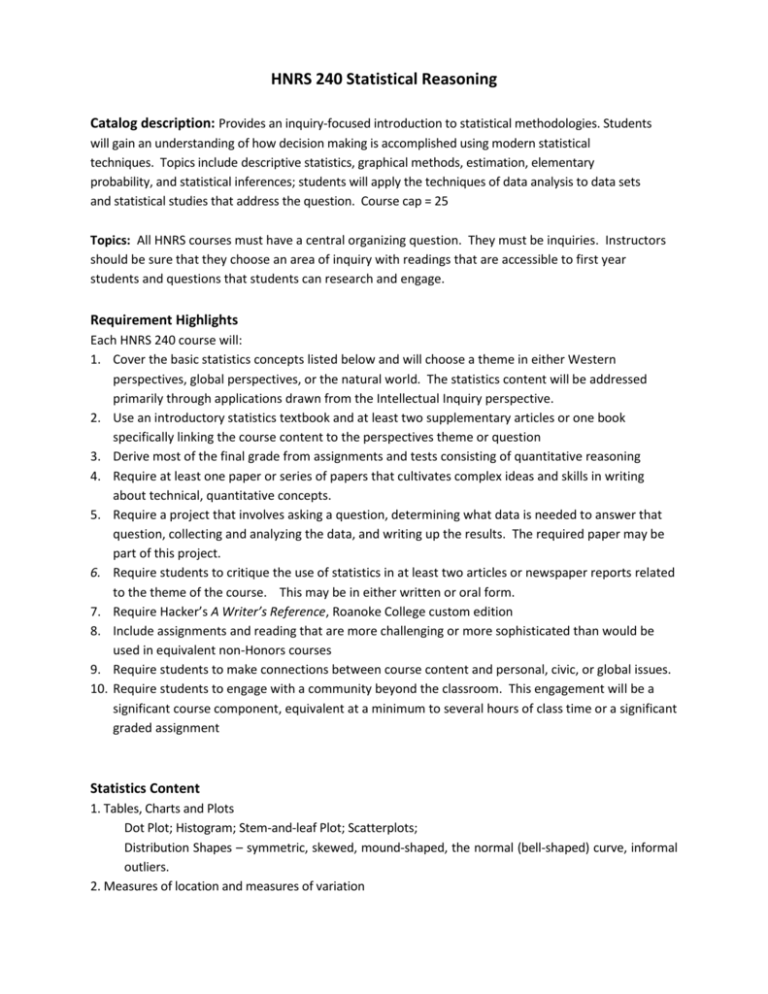
HNRS 240 Statistical Reasoning Catalog description: Provides an inquiry-focused introduction to statistical methodologies. Students will gain an understanding of how decision making is accomplished using modern statistical techniques. Topics include descriptive statistics, graphical methods, estimation, elementary probability, and statistical inferences; students will apply the techniques of data analysis to data sets and statistical studies that address the question. Course cap = 25 Topics: All HNRS courses must have a central organizing question. They must be inquiries. Instructors should be sure that they choose an area of inquiry with readings that are accessible to first year students and questions that students can research and engage. Requirement Highlights Each HNRS 240 course will: 1. Cover the basic statistics concepts listed below and will choose a theme in either Western perspectives, global perspectives, or the natural world. The statistics content will be addressed primarily through applications drawn from the Intellectual Inquiry perspective. 2. Use an introductory statistics textbook and at least two supplementary articles or one book specifically linking the course content to the perspectives theme or question 3. Derive most of the final grade from assignments and tests consisting of quantitative reasoning 4. Require at least one paper or series of papers that cultivates complex ideas and skills in writing about technical, quantitative concepts. 5. Require a project that involves asking a question, determining what data is needed to answer that question, collecting and analyzing the data, and writing up the results. The required paper may be part of this project. 6. Require students to critique the use of statistics in at least two articles or newspaper reports related to the theme of the course. This may be in either written or oral form. 7. Require Hacker’s A Writer’s Reference, Roanoke College custom edition 8. Include assignments and reading that are more challenging or more sophisticated than would be used in equivalent non-Honors courses 9. Require students to make connections between course content and personal, civic, or global issues. 10. Require students to engage with a community beyond the classroom. This engagement will be a significant course component, equivalent at a minimum to several hours of class time or a significant graded assignment Statistics Content 1. Tables, Charts and Plots Dot Plot; Histogram; Stem-and-leaf Plot; Scatterplots; Distribution Shapes – symmetric, skewed, mound-shaped, the normal (bell-shaped) curve, informal outliers. 2. Measures of location and measures of variation Averages – mean, trimmed mean, median; Quartiles and Interquartile Range; The five-number summary and the box plot; A method for determining outliers; Standard deviation and variance 3. Informal inference/Introduction to Probability Informal decision-making from data explorations; Some basic exposure to the ideas of probability using simulations; Some basic probability models and basic probability rules ; The Empirical Rule and an introduction to the normal distribution 4. Sampling Parameters and Statistics; Sampling Distributions; The Central Limit Theorem 5. Formal Inference Confidence Intervals; Hypothesis Testing 6. Introduction to Linear Regression Correlation; Least squares method; Regression coefficients Critical Skills All 200-level HNRS courses address at least two core critical skills. All must address writing. For the second critical skill, faculty may choose either oral presentation or quantitative reasoning. While informal writing is valued, courses must also require at least one polished paper that cultivates complex ideas and appropriate writing skills for the discipline and topic. The faculty has not designated any particular required length or format. We urge faculty to teach writing rather than simply requiring it. Introduce students to the style of writing used in the discipline and why it is valued in that discipline. Show them how source material is incorporated and cited in the discipline. We urge faculty to require a draft and to consider use of peer review, conferences, and consultations with the Writing Center. Courses with oral communication as the second critical skill must require a formal oral presentation. Participation in discussion is not sufficient. Oral presentations may be individual or group. Debates and other variants of presentations are welcomed as long as the assignment requires thesis, support, and advance preparation. Faculty members are urged to teach presentation skills rather than simply requiring a presentation. Courses that emphasize quantitative reasoning as the second critical skill must teach QR skills appropriate for the course’s discipline and include one major or a series of smaller assignments that require students to demonstrate at least three of the following five skills: 1. Gather or select data appropriate for its intended purpose including consideration of appropriate controls, variables, and conditions. 2. Represent data to help reveal its utility for a given purpose by creating tables, graphs, figures, calculations or models. 3. Interpret important features or trends in data from tables, graphs, figures or models. 4. Use data in decision-making; explain how quantitative evidence supports conclusions. 5. Handle uncertainty or significance of data by applying or interpreting measures of uncertainty, error, or statistical significance. Syllabus Checklist In addition to the elements above, the syllabus must include 1. Instructor's office location and office hours 2. Description of course content and teaching methods 3. The learning outcomes for HNRS 240 as listed below. Instructors may, if they wish, include additional learning outcomes beyond the common set or may include some additional comments about how the common learning outcomes are realized in this specific course. 4. Any materials that students are expected to buy, read, or use during the course 5. Classroom and attendance policies (with penalties explained) 6. Assignments students will be required to undertake 7. Grading policy (ideally a grading scale with penalties explained) 8. Testing policy, including make-up tests 9. RC's academic integrity policy as it applies to the class 10. An outline showing proposed topics, students' assignments, reading list, laboratory work, etc. to be required. 11. The focus of inquiry 12. Be sure that any boilerplate sections (e.g. related to tutoring or Writing Center) are up to date and appropriate for the course. Learning Outcomes for HNRS 240-- these must go on the syllabus. Instructors may add sectionspecific outcomes if desired. 1. Students will be able to use the methodologies of statistics to a. Investigate a topic of interest and make decisions based on the results. b. Design and carry out a simple statistical experiment. c. Critique news stories and journal articles that include statistical information. In the critique students will recognize variability and its consequences, identify potential sources of bias and both proper and improper cause and effect inference. 2. Students will be able to articulate the importance and limitations of using data and statistical methods in decision making. 3. Students will be able to write about course topics clearly and effectively. 4. Students will be able to interpret quantitative information related to the course topic. 5. Students will connect course content to their lives and to communities beyond the classroom. For Global Perspective Courses: 6. Students will be able to articulate how the course’s content explores a Global perspective. Additional Notes The instructor may choose to include oral presentation skills in addition to quantitative reasoning and writing. A “focus of inquiry” statement of not more than 150 words is required on the Curriculum Committee proposal form. Remember that this is published in the faculty meeting agenda, but is also the description that students will read in the COL when choosing courses. Think about your audience. DETAILS OF COURSE SCHEDULE AND ASSIGNMENTS Instructors will be asked to describe how this course satisfies all the requirements, and especially how the course satisfies those requirements that distinguish between INQ and HNRS courses. How much detail of the course schedule and assignments does an instructor need to include in a course proposal? Enough to allow the members of GEG and CC to see that the course is meeting the requirements. The committees look at course schedules to see how much time is being spent on readings, how class time is being used, whether instruction in writing is included, whether methodologies are being discussed, if sufficient time for drafting is allowed, and if sufficient time for oral presentations is allowed. Details of assignments can be very helpful to the committee especially in appreciating the use of inquiry or how drafting is being used. While few instructors will have fully detailed assignments sheets, providing some details of the assignment topic and focus helps the committees appreciate what the instructor is doing (with inquiry, methodologies, writing instruction, or other outcomes) and can help avoid a round of clarifying questions. Instructors can include details in the syllabus or in Section 5 of the course proposal. WRITING All HNRS courses must require at least one polished paper. Instructors are strongly encouraged to do more than simply assign writing by including techniques that can help students improve their writing and reasoning. Instructors should consider the use of drafts, peer review, workshops, and Writing Center visits. No minimum page totals are specified.

